╔
La 37ª Copa América en Barcelona. Gestión de la multiculturalidad e implantación de medidas medioambientales y sostenibles
La gestión de la multiculturalidad
The Management of Multiculturism
La candidatura de Barcelona como sede de la Copa América de Vela 2024 ha sido un hito destacado en el mundo de los deportes náuticos. En marzo de 2022, Barcelona fue seleccionada como anfitriona de la 37ª edición de la Copa América, un evento de gran prestigio en el mundo de la vela y el deporte en general. A partir de aquí, todos los equipos empezaron a enviar delegaciones a Barcelona para escoger ubicación para su base operativa, de entre las seis ubicaciones propuestas por el Puerto de Barcelona.
Establecido por el propio protocolo de Copa América, el primero en escoger fue el Defender, es decir, el actual campeón y defensor del título. En este caso el equipo Emirates Team New Zealand (ETNZ). El segundo en elegir su ubicación fue el Challenger of the Record, es decir, el primer equipo que retó al Defender, en este caso el Ineos Britannia. A partir de aquí, la prioridad en la elección de la ubicación la marcaba el orden de inscripción para la presente edición de la Copa América, la 37ª. De esta manera y por este orden, Alinghi Red Bull Racing (Suiza), Luna Rossa Prada Pirelli (Italia), NYYC American Magic (EUA) y Orient Express Racing Team (Francia) escogieron sus ubicaciones quedando ya definida la posición que cada equipo ocuparía en el Port Vell para preparar y disputar la competición.
Barcelona’s bid to host the 2024 America’s Cup of Sailing has been a significant milestone in the world of nautical sports. In March 2022, Barcelona was selected as the host city for the 37th edition of the America’s Cup, a prestigious event in the world of sailing and sports in general. From that point on, all teams began sending delegations to Barcelona to choose a location for their operational base from the six locations proposed by the Port of Barcelona.
As per America’s Cup protocol, the first to choose was the Defender, meaning the current champion and title holder. In this case, the team Emirates Team New Zealand (ETNZ). The second to choose their location was the Challenger, meaning the first team to challenge the Defender, in this case, Ineos Britannia. From here, the priority in selecting the location followed the order of registration for this edition of the America’s Cup, the 37th. In this way and in this order, Alinghi Red Bull Racing (Switzerland), Luna Rossa Prada Pirelli (Italy), NYYC American Magic (USA), and Orient Express Racing Team (France) chose their locations, thus defining the position each team would occupy in the Port Vell to prepare for and compete in the event.
Guideline
A partir de ese momento, los equipos empezaron a enviar propuestas constructivas para sus respectivas bases, pero de forma muy desordenada, sin seguir un criterio único, adaptándose a diferentes normativas internacionales, pero sin conocimiento de la normativa local y de nuestro país en lo referente a los estándares de construcción. Se hizo evidente, en este momento, la diversidad de culturas y formas de entender de los diferentes equipos, así como la necesidad de coordinar esta diversidad y aprovechar lo mejor de cada uno para constituir un documento guía único para todos.
Guidelines
From that point on, the teams began submitting construction proposals for their respective bases, but in a very disorganized manner, without following a unified criterion. They adapted to various international regulations but lacked knowledge of local rules and standards concerning construction in Spain, Catalonia, Barcelona, and the Port of Barcelona. At this moment, the diversity of cultures and approaches among the different teams became evident, as well as the need to coordinate this diversity and leverage the best aspects of each to create a single guiding document for all.
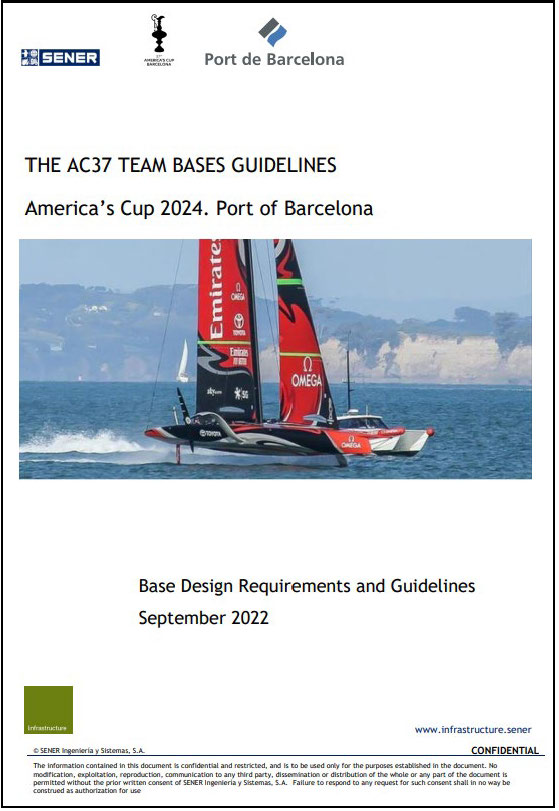
Portada del Guideline. (Fuente: Oficina de Coordinación de la Copa América, Port de Barcelona).
Cover of Guidelines. (Source: America’s Cup Coordination Office, Port of Barcelona).
Es por ello y para garantizar el cumplimiento de las normativas constructivas en España, Cataluña, Barcelona y el Puerto de Barcelona, la Oficina de Coordinación de Copa América redactó una guía Técnica (Guideline) para el desarrollo del Proyecto de las Bases en Julio 2022 (y aprobada en Setiembre de 2022), de obligado cumplimiento para los Proyectos de los Equipos.
Se aprovechó además para incorporar en dicha guía las medidas ambientales de obligado cumplimiento a las que se debían que sujetar todos los equipos.
Dicha guía favoreció la presentación de Proyectos homogéneos, con el correcto del cumplimiento de los estándares de construcción y la obligación de implementación de medidas ambientales.
For this reason, and to ensure compliance with construction regulations in Spain, Catalonia, Barcelona, and the Port of Barcelona, the America’s Cup Coordination Office drafted the Technical Guidelines for the development of the Base Project in July 2022 (which was approved in September 2022). These guidelines became mandatory for the teams’ projects.
It was also an opportunity to incorporate mandatory environmental measures that all teams had to adhere to.
This guideline facilitated the submission of homogeneous projects, ensuring proper compliance with construction standards and the obligation to implement environmental measures.
Implantación de medidas medioambientales y sostenibles
The Implementation of Environmental and Sustainability Measures
Tal y como se ha comentado anteriormente, se aprovechó la ocasión de la creación del Guideline entregado a todos los equipos para poner en valor los retos de presente que la Autoridad Portuaria de Barcelona considera esenciales para el desarrollo de actividad dentro de la zona portuaria, introduciendo medidas ambientales y de sostenibilidad que debían ser cumplidas por todos los equipos participantes en el evento.
Materiales
El uso de materiales de construcción provenientes de fuentes menos contaminantes, así como la reutilización de estructuras que los equipos ya disponían de anteriores ediciones de Copa América, fueron dos requisitos básicos en este apartado y que en algunos casos obligó a reconfigurar el espacio ocupado y la distribución interna dentro de las bases para poder aprovechar y reutilizar al máximo materiales de los que ya se disponía.
Hay que destacar en este apartado las bases de American Magic y Luna Rossa, que fueron las que cumplieron más fielmente con este requerimiento y que, a través de sus proyectos, lograron rediseñar su base, incluyendo la zona de los hangares donde guardaban y trabajaban con sus embarcaciones, así como sus oficinas y el espacio destinado a sus invitados (hospitality).
As previously mentioned, the creation of the Guidelines provided to all the teams was also an opportunity to highlight the current challenges that the Port Authority of Barcelona considers essential for the development of activities within the port area. It introduced environmental and sustainability measures that all teams participating in the event had to comply with.
Materials
The use of construction materials from less polluting sources, as well as the reuse of structures that teams had from previous editions of the America’s Cup, were two basic requirements in this area. In some cases, this required reconfiguring the occupied space and the internal layout of the bases in order to maximize the reuse of materials already available.
It is worth highlighting the bases of American Magic and Luna Rossa, as these were the ones that most faithfully adhered to this requirement. Through their projects, they managed to redesign their base, including the area of the hangars where they stored and worked on their boats, as well as their offices and the hospitality area.
Construcción de la base American Magic. (Fuente: Oficina de Coordinación de la Copa América, Port de Barcelona).
Construction of the American Magic base. (Source: America’s Cup Coordination Office, Port of Barcelona).
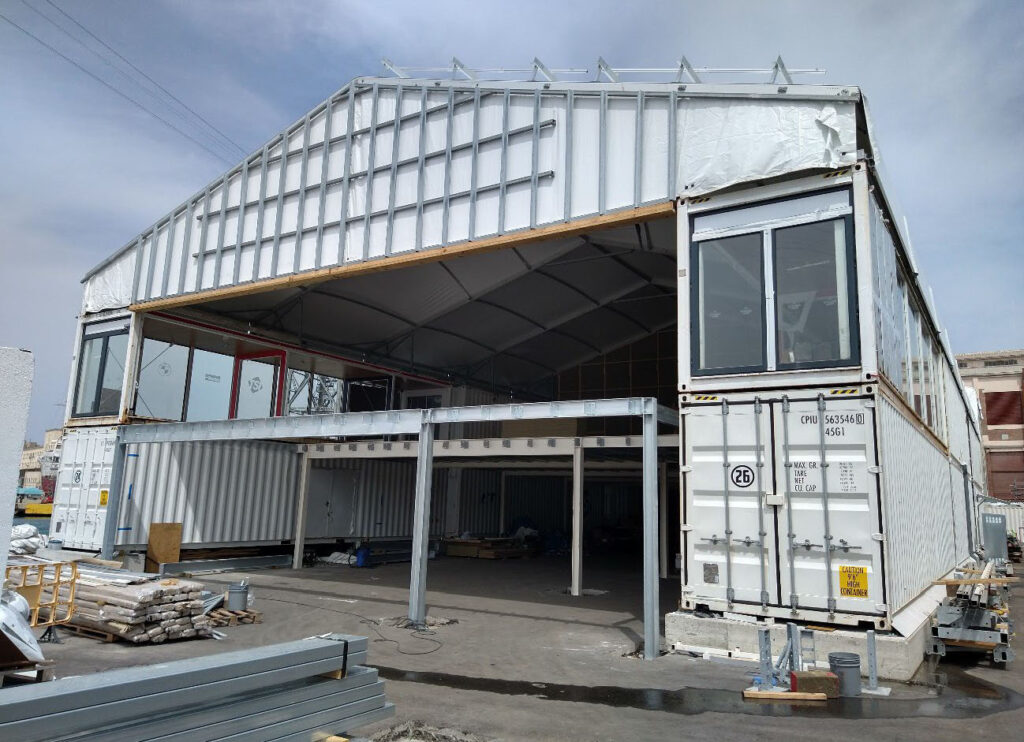
Construcción de la base Luna Rossa Prada Pirelli. (Fuente: Oficina de Coordinación de la Copa América, Port de Barcelona).
Construction of the Luna Rossa Base Prada Pirelli. (Source: America’s Cup Coordination Office, Port of Barcelona).

Energía
Con relación a la energía, se diseñaron interiores teniendo en cuenta los flujos de corrientes para la compensación de temperaturas y minimizando el consumo tanto de aires acondicionados como de calefacción.
Asimismo, la instalación de placas solares fueron elementos de obligado cumplimiento de manera que se pudiera cubrir toda la demanda eléctrica de la base, debiendo cubrir entre el 20 y el 40% de la superficie de cubierta con una instalación fotovoltaica.
También se implantó un sistema de gestión de consumos por parte de cada base con el fin de optimizar los mismos.
Agua
El ahorro y eficiencia en su consumo se estableció en el Guideline y cobró más valor si cabe tras la crisis de sequía en los meses previos a la celebración de la competición que sufrió nuestro país. Por este motivo, la Autoridad Portuaria de Barcelona, el Ayuntamiento de Barcelona y la organización del evento acordaron que todos los equipos debían instalar de forma obligatoria métodos de agua reutilizada o desalada en sus bases.
Los equipos optaron por diferentes medidas de optimización como fueron la desalinización de agua captada del mar, la utilización para el baldeo de agua regenerada, la depuración de aguas grises para el mismo fin, la recolecta de aguas de lluvia y de lavados, así como la reutilización del agua procedente de los filtros de aire acondicionado.
De esta manera se redujo a prácticamente a cero el consumo de agua de red para usos que no fueran imprescindibles.
Energy
Regarding energy, the interiors were designed taking into account airflows to balance temperatures, minimizing the use of air conditioning and heating.
Additionally, the installation of solar panels became a mandatory requirement to cover the entire electrical demand of the base. The system had to cover between 20% and 40% of the roof area with photovoltaic panels.
A consumption management system was also implemented by each base to optimize energy use.
Water
Water conservation and efficiency in its consumption were established in the Guidelines and gained even more significance following the drought crisis in the months leading up to the competition, which affected our country. For this reason, the Port Authority of Barcelona, the City Council of Barcelona, and the event organizers agreed that all teams must install methods of reusing or desalinating water at their bases.
The teams opted for different optimization measures, such as desalinating water drawn from the sea, using regenerated water for washing purposes, purifying gray water for the same purpose, collecting rainwater and water from washdowns, as well as reusing water from air conditioning filters.
This approach reduced the consumption of tap water for non-essential uses to nearly zero.
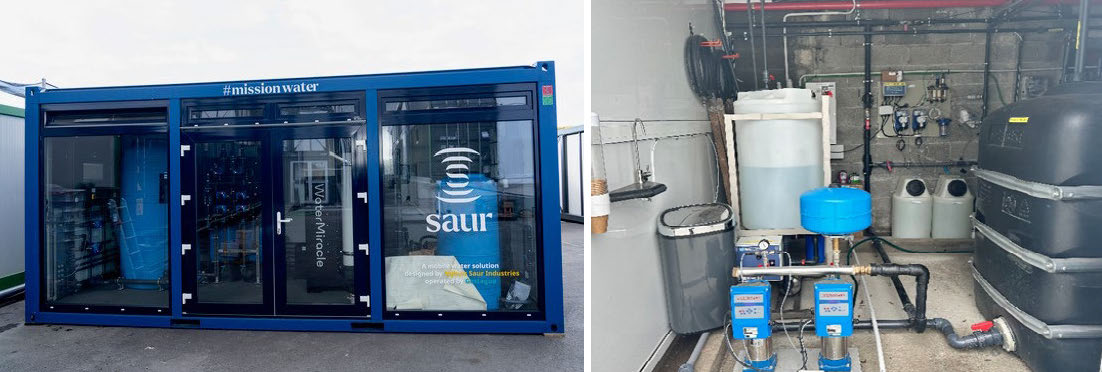
Sistema de aprovechamiento de aguas de Orient Express Racing Team (izquierda). Desaladora de agua de Alinghi Red Bull Racing (derecha). (Fuente: Oficina de Coordinación de la Copa América, Port de Barcelona).
Water utilization system of Orient Express Racing Team (left). Water desalination unit of Alinghi Red Bull Racing (right). (Source: America’s Cup Coordination Office, Port of Barcelona).
Mobilidad y transporte
Por mar: se instó a los equipos a contar con embarcaciones de apoyo propulsadas por energías limpias (electricidad, H2).
Por tierra: se solicitó a los equipos que en caso de necesitar vehículos de 4 ruedas para sus operativas diarias, estos fueran de emisión cero. Además, se facilitaron espacios dentro de la propia base para el aparcamiento de bicicletas, de manera que los trabajadores (hasta 160 en algunos equipos) pudieran llegar a la base en dicho modo de transporte. Se consiguió hasta un 80% de desplazamientos mediante este modo de transporte.
Mobility and Transport
By sea: teams were encouraged to use support vessels powered by clean energy (electricity, H2).
By land: teams were asked if in the case of using four-wheel vehicles for their daily operations, that they were zero-emission. Additionally, parking spaces for bicycles were provided within the base so that workers (up to 160 in some teams) could reach the base using this mode of transportation. This led to achieving up to 80% of commutes via this transportation method.
Alinghi fue el equipo con un parque de bicicletas más grande de todos los equipos competidores. (Fuente: Oficina de Coordinación de la Copa América, Port de Barcelona; Courtesy: Alinghi, alinghi.com).
Alinghi was the team with the largest fleet of bicycles among all the competing teams. (Source: America’s Cup Coordination Office, Port of Barcelona; Courtesy: Alinghi, alinghi.com).
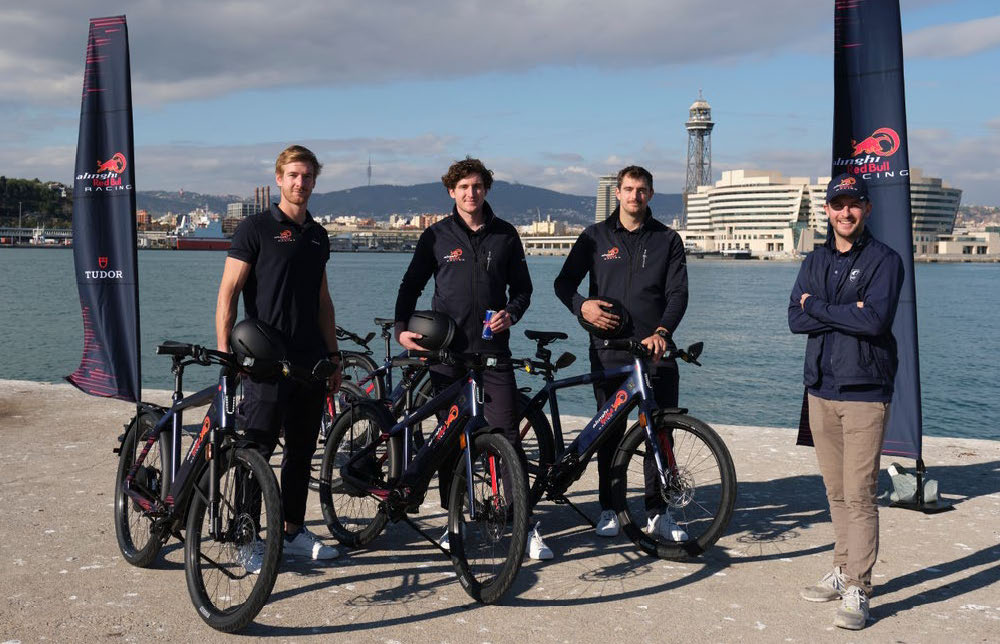
Reducción de generación residuos
Todos los equipos presentaron un plan de reducción y correcta gestión de sus residuos, siguiendo las medidas adecuadas de reciclaje en diferentes contenedores, recogida y trazabilidad de estos.
Reduction of Waste Generation
All teams submitted a plan for the reduction and proper management of their waste, following appropriate recycling measures with different containers, collection, and traceability.
Otras medidas impulsadas
Other Measures Introduced
Hay que destacar en este apartado los proyectos innovadores y, que hicieron de la 37ª edición de la Louis Vuitton America’s Cup en Barcelona la más sostenible de la historia de la competición. Entre estos proyectos podemos encontrar el proyecto de las embarcaciones propulsadas a través de hidrógeno y el proyecto Sotamar.
Proyecto H2
Por iniciativa de la organización y con el total apoyo del Puerto de Barcelona, se desarrollaron 10 embarcaciones de apoyo propulsadas mediante hidrógeno, una por equipo y cuatro por parte de la organización. Dichas embarcaciones necesitaban un único punto de suministro cercano a todas las bases y al mismo tiempo, ubicado en un espacio que cumpliera con toda la normativa aplicable para estos casos.
Es por ello por lo que, en una primera fase, verano de 2023, se implantó estación móvil de suministro de hidrógeno en Drassanes, espacio cerrado y protegido en aquel momento. En esta fase, solamente se dio suministro a una embarcación, el Chase Zero del equipo neozelandés.
Posteriormente, en una segunda fase, se implantó ya la hidrolinera con capacidad para suministrar a todas las embarcaciones en el Muelle de Poniente, en verano de 2024.
In this section, it’s worth highlighting the innovative projects that made the 37th edition of the Louis Vuitton America’s Cup in Barcelona the most sustainable in the competition’s history. Among these projects are the hydrogen-powered vessels project and the Sotamar project.
Project H2
At the initiative of the organization and with the full support of the Port of Barcelona, 10 hydrogen-powered support vessels were developed, one for each team and four for the organization. These vessels required a single supply point close to all the bases, and at the same time, located in an area that met all the necessary regulations for such cases.
For this reason, in the first phase, during the summer of 2023, a mobile hydrogen supply station was installed in Drassanes, a closed and protected area at that time. In this phase, only one vessel, the Chase Zero from the New Zealand team, was supplied.
Later, in the second phase, a hydrogen refueling station with the capacity to supply all the vessels was set up at the Poniente Dock in the summer of 2024.
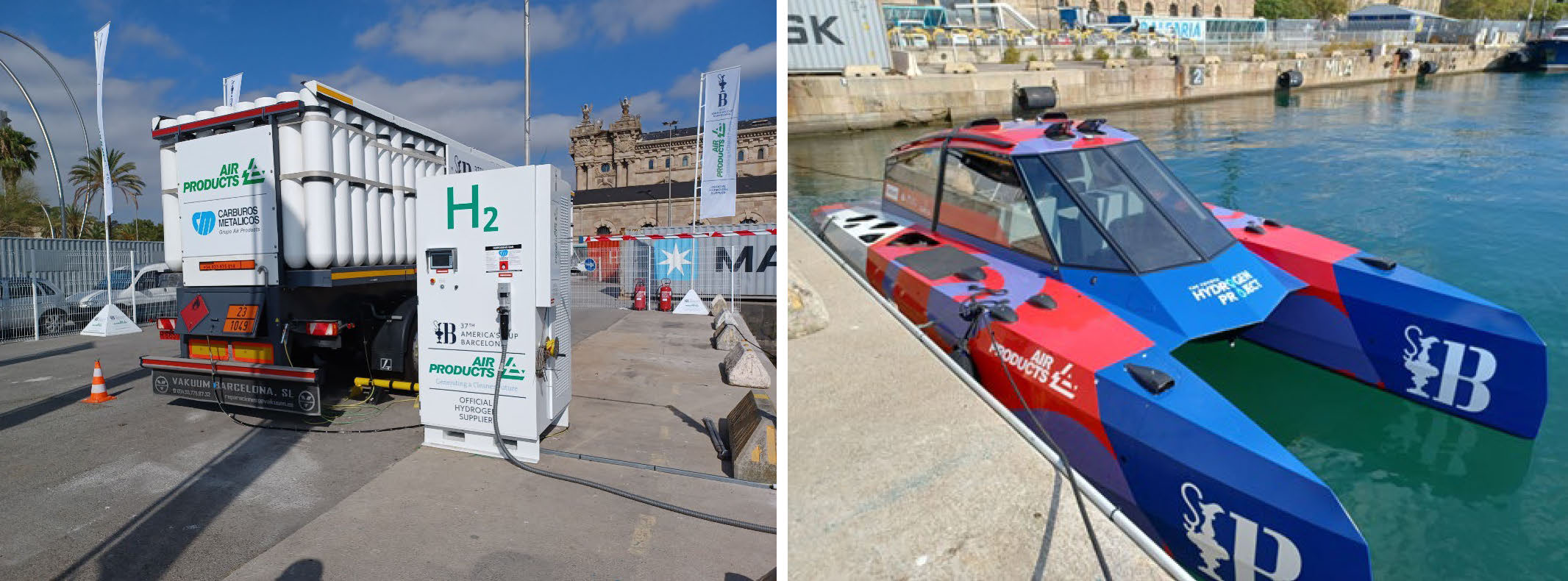
Sumministro de hidrógeno en la 1ª fase en muelle Drassanes (izquierda). Embarcación propulsado por hidrógeno en la 1ª fase de la hidrolinera (derecha). (Fuente: Oficina de Coordinación de la Copa América, Port de Barcelona).
Hydrogen supply in the 1st phase at Drassanes dock (left). Hydrogen-powered vessel in the 1st phase of the hydrogen refueling station (right). (Source: America’s Cup Coordination Office, Port of Barcelona).
Proyecto Sotamar
A finales de diciembre de 2023, la organización del evento (ACE Barcelona S.L) conjuntamente con World Sailing abrieron una licitación referida como “Proyecto insígnia de sostenibilidad” dirigida a entidades tanto públicas como privadas y con el fin de presentar un proyecto que cumpliese una serie de requisitos medioambientales y de sostenibilidad de manera que pueda perdurar en el tiempo más allá de la Copa América, es decir, dejar un legado a esta ciudad después de la finalización del evento.
Entre 19 empresas que se presentaron, la Fundación BCN Port Innovation en dependencia del Puerto de Barcelona y con la colaboración de Port Vell, Clúster Nàutic y Nova Bocana Barcelona con su proyecto “Sotamar”, fueron el adjudicatario de dicha licitación. La propuesta se centraba en el fomento de la regeneración del fondo marino (frente a la playa de Sant Sebastian), en el impulso a la economía azul sostenible y en la innovación y transferencia tecnológica (uso de hormigón azul y drones submarinos de seguimiento).
Project Sotamar
At the end of December 2023, the event organization (ACE Barcelona S.L) in collaboration with World Sailing opened a tender referred to as the “Sustainability Flagship Project,” aimed at both public and private entities. The goal was to present a project that met a series of environmental and sustainability requirements, ensuring it could endure beyond the America’s Cup, leaving a legacy for the city after the event concluded.
Out of the 19 companies that applied, the Fundación BCN Port Innovation, under the Port of Barcelona and in collaboration with Port Vell, the Nàutic Cluster, and Nova Bocana Barcelona, with their project “Sotamar,” were awarded the tender.
The proposal focused on promoting the regeneration of the seabed (off the Sant Sebastian beach), supporting the sustainable blue economy, and encouraging innovation and technological transfer (such as the use of blue concrete and underwater drones for monitoring).

Biotopos marinos para la regeneración del fondo marino (izquierda). Divulgación de la regeneración del fondo marino (derecha). (Fuente: Oficina de Coordinación de la Copa América, Port de Barcelona).
Marine biotopes for seabed regeneration (left). Public outreach on seabed regeneration (right). (Source: America’s Cup Coordination Office, Port of Barcelona).

Logo de America’s Cup en el recinto principal del Aquàrium de Barcelona (izquierda). Experiencia inmersiva relativa a la divulgación del proyecto Sotamar (derecha). (Fuente: Oficina de Coordinación de la Copa América, Port de Barcelona).
America’s Cup logo at the main area of the Barcelona Aquarium (left). Immersive experience related to the outreach of the Sotamar project (right). (Source: America’s Cup Coordination Office, Port of Barcelona).
IMAGEN INICIAL | Paneles fotovoltaicos en la base del Luna Rossa Prada Pirelli. (Fuente: Oficina de Coordinación de la America’s Cup, Puerto de Barcelona).
HEAD IMAGE | Photovoltaic panels at the Luna Rossa Prada Pirelli base. (Source: America’s Cup Coordination Office, Port of Barcelona).